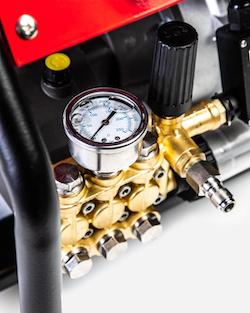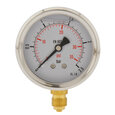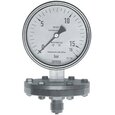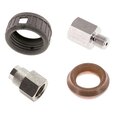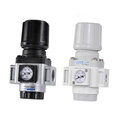Pressure Washer Gauge - How it Works
Pressure washer pressure gauges are essential tools for monitoring the pressure output of a pressure washer. They allow a user to easily read and adjust the pressure to ensure that it is at the appropriate level for the task at hand. These gauges can be either mechanical or digital, are typically easy to install, and can help to prolong the life of the pressure washer by preventing over pressurization. This article focuses on pressure gauges on a pressure washer. Learn more about how gauges work by reading our pressure gauge overview article.
Table of contents
- What is a pressure washer?
- Pressure washer gauge operating principle
- Functions of pressure washer gauge
- Selection criteria
View our online selection of pressure gauges!
What is a pressure washer?
A pressure washer (Figure 2) is a mechanical device that uses a high-pressure water jet to clean surfaces such as buildings, vehicles, concrete, and decks. It pumps water from a low-pressure source and uses a pressure boost to a much higher pressure, to achieve the required cleaning power. Pressure washers can be powered by gasoline, diesel, or electricity. They typically have a hose, wand, and nozzle to deliver the high-pressure water stream, and can have various attachments to enable different cleaning methods.
There are two types of pressure washers: hot water and cold water pressure washers.
- Hot water: Hot water pressure washers are popular in industrial applications for cleaning oils and grease from a surface. They operate at temperatures ranging from 49 °C (120 °F) to 165 °C (330 °F). When operating at temperatures above water’s boiling point, the pressure washer uses superheated water or steam.
- Cold water: Cold water pressure washers are more applicable for home owners because they do not operate at dangerous temperatures. They typically operate between 4 °C (40 °F) and 27 °C (80 °F).
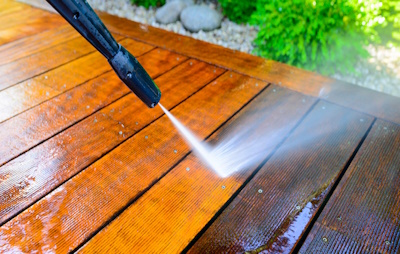
Figure 2: A pressure washer washing dirt and stains off a deck.
Pressure washer gauge operating principle
Pressure washer gauges can have a pressure scale of over 2,000 bar (29,000 psi). They measure the pressure at the pressure boost outlet, which is the pressure in the hose. Some pressure washers have a pressure gauge that measures pressure at the pump inlet. However, these gauges have a much lower scale.
The operation of a pressure washer gauge depends on the type of gauge. Pressure washers typically have a bourdon tube gauge or a diaphragm gauge.
- Bourdon: A bourdon pressure gauge has a curved tube inside. Water enters one end of the tube and the water’s pressure causes the tube to begin straightening. The needle valve moves proportionally to the tube’s amount of straightening. A pressure washer’s pressure can fluctuate rapidly, causing the pressure gauge’s needle to move erratically. Therefore, they typically have a liquid filled pressure gauge (Figure 3) and a snubber at the gauge’s inlet.
- Diaphragm: A diaphragm gauge has a flexible diaphragm that separates the gauge mechanism and the pressure being measured. Differences in pressure translate to different diaphragm movement, which moves the indicator needle connected to the gauge mechanism.
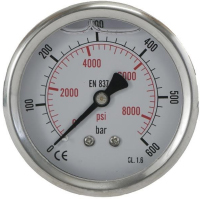
Figure 3: A glycerin pressure gauge for pressure washers.
Functions of pressure washer gauge
Pressure gauges are an important instrument when operating a pressure washer. The following are some of the functions of a gauge on a pressure washer:
- Measurement: The primary function of a pressure washer gauge is to measure the pressure levels of the pump.
- Diagnostics: The gauge can show an indication of damage to the pump’s internal components.
- Calibration: The pressure gauge helps to calibrate the pressure washer pump operation.
- Cavitation: When at the suction side of the pump, the pressure gauge can help indicate the onset of cavitation.
Selection criteria
- Measuring range: Pressure washers operate at relatively high pressure compared to conventional applications. It is typical to have pressure gauges from 50 bar to 2,000 bar (725 psi - 29,000 psi). Allow about 10% higher range than the expected maximum pressure of the pressure washer to avoid damage. Always choose the narrowest measuring range whenever possible for higher accuracy.
- Connection size and type: Pressure washer gauges come in different connection sizes. It is common to use an inline adapter to connect the pressure gauge between the pump and the hose. The most common connection type is threaded.
- Connection material: Pressure washer gauges can come with different connection materials such as brass and copper alloy. Ensure the selected material is compatible with the pump discharge material or hose. Read our material compatibility chart to help decide the best material.
- Maximum operating temperature: Most pressure washer gauges for residential and commercial applications work within a 4 °C (40 °F) and 27 °C (80 °F) maximum temperature range. There are special pressure washer gauges for high-temperature industrial applications. These gauges are typically made of stainless steel or bronze and may have a temperature gauge as well.
- Unit of measurement: For gauge pressure measurement, it is quite common to have both bar and psi.
Learn more about selecting a pressure washer gauge by reading our pressure gauge selection tips.




